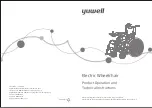
26
9 4 Disposal
v-max and its batteries must not be disposed of in places that are not
intended for this purpose (e.g. landfills) according to the current legisla
-
tion in force in each respective country. Substances may be present that
could prove to be harmful to the environment.
The product marked with a crossed wheelie bin cannot be disposed of
with household waste (WEEE Directive). Inform yourself about the valid
statutory provision in your country as the WEEE regulation is not appli-
cable in all European countries.
Your v-max and its batteries are durable products. After expiry of the natural service life, you can return
these components to AAT Alber Antriebstechnik GmbH or their specialist dealers for disposal.
9 5 Long-term storage
If v-max is not used for an extended period of time (e.g. over several months), observe the following
information:
•
Observe the wheelchair manufacturer’s information if the wheelchair is to be stored!
•
No moisture must be allowed to enter the interior of the device!
•
Store in dry rooms and avoid excessive air humidity. Cover with film, if necessary!
•
Protect against permanent exposure to sunlight!
•
Unauthorised persons, particularly children, should not have unsupervised access to the storage
location of v-max!
•
Remove the battery back before placing in storage!
•
Secure the power cable with the immobiliser if required (chapter 6.4)
•
Observe the safety instructions in chapter 9.1 for placing the battery pack in storage!
If the v-max is to be put into operation again, clean the wheelchair and the product (chapter 9.3).
Check whether a technical safety test must be performed (see chapter 9.6.).
If a technical safety test is not necessary, electrical function, anti-tilt supports, brackets and, if necessary,
the air pressure of the castors must be checked prior to start-up!
Summary of Contents for v-max
Page 1: ...www aat online de EN 2018 05 2 1 Translation of the original user manual v max...
Page 30: ...30 Notes...
Page 31: ...31 Notes...







































